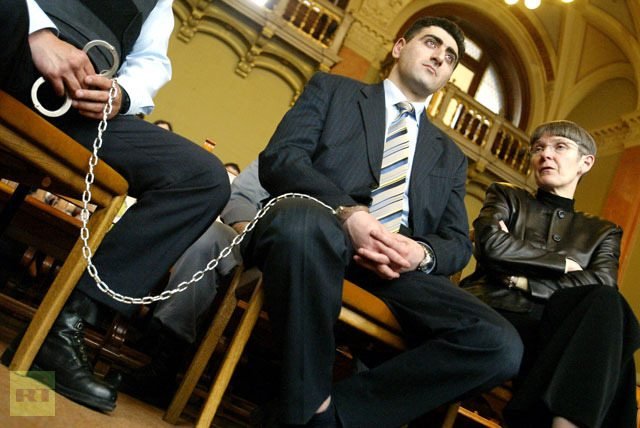As an Armenian refugee from Baku, Azerbaijan, senseless, violent acts committed against innocent Armenian women, men, and children by Azeris no longer shock me. I was forced to grow up with their hatred and violence, committed on the basis of nationality alone. It doesn’t surprise me in the least.

In 1988, the Azeri government orchestrated pogroms on the Armenian citizens of Sumgait, Kirovabad, and Baku. Twenty-some years later, the existing Azeri government hardly differs from its predecessor in its continual propaganda and education of ignorance, distrust, and obsessive hatred toward Armenians as a whole.
The brutal murder of Armenian officer Gourgen Markarian in Budapest in 2004 is no exception. The Azeri officer, Ramil Safarov, who murdered the sleeping victim with an axe was sentenced to life in prison by the Hungarian judicial system. That is where the story should have ended.
But of course the story doesn’t end there, and that is because we’re talking about Azerbaijan. The Azerbaijani bribery and corruption machine is in full force, as oil money keeps flooding the pockets of the Aliyevs. While the general population is not thriving economically, as would be expected, the government wields its money to buy championship trophies, build enormous structures to show off its fortune, and buy its power. It’s done within the region, and apparently it’s now done outside of the region.
Hungary’s extradition of a brutal murderer back to Azerbaijan is not an isolated event that hurts officer Markarian’s family alone. That act, and the subsequent pardon of the murderer, Safarov, by the Azeri government are quite possibly a violation of international law and a clear message to the world that Azerbaijan is not a democracy that respects international law and human rights of all mankind, as it proclaims.
Aside from the pain I feel as an Armenian—with my home uprooted and destroyed, my childhood demolished—I also feel the pain of history repeating itself: The Azeris slaughtered Armenians in Azerbaijan in 1980’s. The Turks slaughtered Armenians during the genocide in 1915. No one is brought to justice. The world turns away. And it is happening again. It cannot happen again. We cannot let it happen again.
The world, along with Hungary, must stand by the Armenians. The world must see the Azeri dictatorship for what it is, in all its violence. And Nagorno-Karabagh Armenians must be free from Azeri rule. Because if an Azeri “hero” can slaughter an Armenian in his sleep on foreign soil and get praised for it, imagine what he will do within his own borders. The Nagorno-Karabagh Republic must be independent. Now more than ever.
Anna Astvatsaturian Turcotte is the author of Nowhere, a Story of Exile.


I would like to know something about the repression of Armenians in Azerbaijan from the time of the Soviet takeover of Armenia in 1920 up to the progroms of the late 1980’s – both in Artsakh and in Azerbaijan proper.
I think it would be very instructive.
Repressions of Armenians by Azeri Turks….
Where should we start? Probably with the Baku pogroms of 1905. Interesting information could be found in Western press of the time.
More details at http://www.baku.am
Keep in mind that the artificial nation of “Azerbaijanis” did not exist yet, so they were called “Transcaucasian Tartars” and they called themselves “muslims” when they were talking to others and different tribal names when they were among themselves.
This was followed by pogroms of 1918 culminating with the Turkish Expeditionary Corps under the command of general Nuri Pasha (nephew of Enver Pasha) taking Baku on September 15th after a 1.5 month siege and massacring about 30,000 Armenians in the following three days.
Overall, Turkish army and local tartars massacred hundreds of thousands of Armenians including 20,000 in July – August 1918 in Vartashen (now Oguz) and Kutkashen (now Gabala) districts, 65,000 in August-September 1918 in Nukhi-Aresh region, and 20,000 in Artsakh and Utik. By the end of 1918 Turkish aggressors completely cleansed native Armenian population of Getabek, Kubatly, Zangelan, Kelbajar, Lachin, Agdam, Jebrail, and Fizuli districts creating space for their artificial bastard Axerbajan Republic.
In March 1920 they burned Shushi massacring 30,000 Armenian inhabitants there. The ruins of this town were kept intact by the Azeri Turk rulers up until Shushi was liberated on May 9, 1991. The ruins were kept to remind Armenians not to re-settle Shushi even during the “peaceful” Soviet times.
This is a very important chapter of the Armenian Genocide because it destroys the myth that the Genocide was committed by the Osman Empire and modern Turkish Repulic has nothing to do with it.